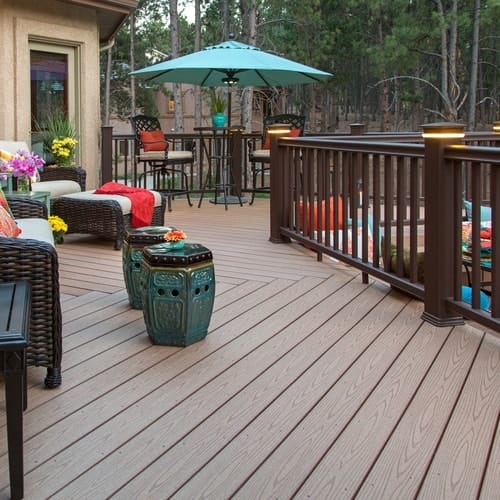Water-Based Stains for Your Deck: Advantages and Applications
Water-Based Stains for Your Deck: Advantages and Applications
Blog Article
A Comprehensive Guide to Different Sorts Of Deck Staining Techniques for Ultimate Security and Visual Appeals
In the realm of deck maintenance, the art of discoloring stands as an essential step towards both protecting the stability of your outside room and boosting its aesthetic allure. As we browse with the detailed world of deck staining techniques, one begins to appreciate the nuanced methods that can make all the difference between a mediocre finish and a flawless one. From the selection of the suitable discolor type to the precise application methods, each aspect plays an important function in accomplishing that best balance between protection and visual appeals. Join us as we uncover the keys behind achieving the utmost deck staining results-- a trip where every brushstroke shapes not simply the surface area, but the extremely significance of your exterior refuge.
Understanding Various Types of Stains
Various kinds of stains are frequently utilized in the procedure of deck discoloration to accomplish different visual and protective results. Transparent discolorations are excellent for showcasing the natural grain of the timber while supplying marginal defense versus UV rays and wetness. On the various other hand, semi-transparent spots use an equilibrium in between color enhancement and protection, permitting some wood grain to reveal through. For a much more opaque surface that gives optimum security versus the elements, solid stains are the favored selection. These stains can be found in a broad variety of colors and effectively conceal the timber grain.
Additionally, there are likewise specialized discolorations such as sealers and printer toners. Toners include a tip of shade to the timber while providing very little defense, making them suitable for newer decks with less wear. Sealers, on the various other hand, deal defense against wetness and UV rays without adding shade, making them a preferred choice for decks that already boast a desirable color. Understanding the qualities and benefits of each type of discolor is critical for achieving the preferred look and toughness for your deck.
Choosing the Right Discoloration Color
When considering the looks of your deck discoloration project, the choice of tarnish shade plays an essential role in enhancing the safety high qualities of the selected tarnish kind (Stain Deck). The shade you select can substantially impact the total appearance of your deck, as well as its capacity to withstand the elements in time
When selecting a tarnish color, it's important to take into consideration the existing color pattern of your home's outside. Integrating the deck tarnish with the general visual of your property can develop a cohesive and aesthetically attractive outside space. In addition, the color of your deck tarnish can influence the temperature level of the deck surface; darker shades have a tendency to absorb more warmth, while lighter colors mirror sunlight and stay cooler.
In addition, the kind of timber you are staining will additionally affect just how the stain shade appears. Different timber varieties can communicate with the tarnish in various methods, potentially changing the final color. It's suggested to test the discolor on a tiny, unnoticeable location of the deck to guarantee the shade transforms out as desired before continuing with the entire job.
Preparing Your Deck for Discoloration
To make certain a successful and lasting deck staining project, comprehensive preparation of the deck surface is crucial. Begin by cleaning the deck thoroughly to get rid of dust, crud, mold, and any type of old tarnish or end up.
Check the deck for any type of damaged or rotten boards that need to be changed. Hammer down any kind of protruding nails and sand any kind of harsh areas to guarantee a smooth surface for discoloration. Examine for any type of loose barriers or actions that might require tightening up or repair service.
Once the deck is tidy, dry, and in good fixing, consider using a timber brightener to bring back the deck's natural shade and open up the timber pores for better discolor penetration. Ultimately, safeguard any close-by plants, furniture, or surface areas with plastic sheet prior to waging the staining procedure. Correct prep work is key to accomplishing a professional-looking coating and making best use get redirected here of the durability of your deck tarnish.
Applying Spot With Different Strategies
For a expert and remarkable surface, the approach of using stain plays an essential duty in enhancing the appearance and longevity of your deck. There are several methods you can utilize to make certain a reliable application of discolor.
Brushing is a standard approach that permits precision and control over the quantity of discolor applied. It is ideal for detailed areas and reaching in between deck boards (Stain Deck). Rolling is a quicker option, covering larger surface successfully. Nonetheless, back-brushing after rolling is recommended to even out the discolor and work it into the wood for much better infiltration.
Spraying is one more prominent technique, providing speed and ease of application, especially for huge deck locations. It is very important to make use of a top quality sprayer and bear in mind overspray. Pad applicators offer a smooth and even complete and are appropriate for both horizontal and vertical surface areas. Whichever method you choose, making sure correct preparation and following manufacturer standards will certainly assist achieve a attractive and durable stain coating on your deck.

Maintaining and Re-staining Your Deck
Proper maintenance and prompt re-staining are crucial for maintaining the elegance and longevity of your deck. Regular maintenance jobs consist of sweeping off debris, cleaning with a deck cleaner, and evaluating for any kind of signs of wear or damages. Resolving concerns immediately can avoid much more significant troubles in the future. When it involves re-staining your deck, the frequency depends on numerous aspects such as the type of stain made use of, the climate in your area, and exactly how much deterioration your deck experiences. Generally, it is advised to re-stain your deck every 2-4 years to preserve its protection and aesthetics.
Prior to re-staining, ensure the deck is tidy, dry, and devoid of any previous tarnish residue. Fining sand may be essential to smooth out harsh areas or eliminate old tarnish that is flaking. Select a premium tarnish that matches your deck's product and provides the desired degree of protection. Apply the tarnish evenly making use of the appropriate method discussed earlier in this overview to ensure a lasting and lovely surface - Right Deck Stain. By remaining aggressive with maintenance and re-staining, you can delight in a visually enticing and well-protected deck for years to come.
Conclusion
In verdict, understanding the different types of deck stains, choosing the best shade, properly preparing the deck, applying stain with various techniques, and re-staining the deck and maintaining are important steps for utmost defense and view website aesthetics. By following these actions, you can make certain that your deck continues to be in leading problem for many years to find.
In addition, the shade of your deck discolor can influence the temperature of the deck surface area; darker shades have a tendency to take in more heat, while lighter shades mirror sunlight and stay cooler.
It's advisable to test the tarnish on a little, unnoticeable location of the deck to make certain the shade turns out as desired prior to proceeding with the entire task.

Report this page